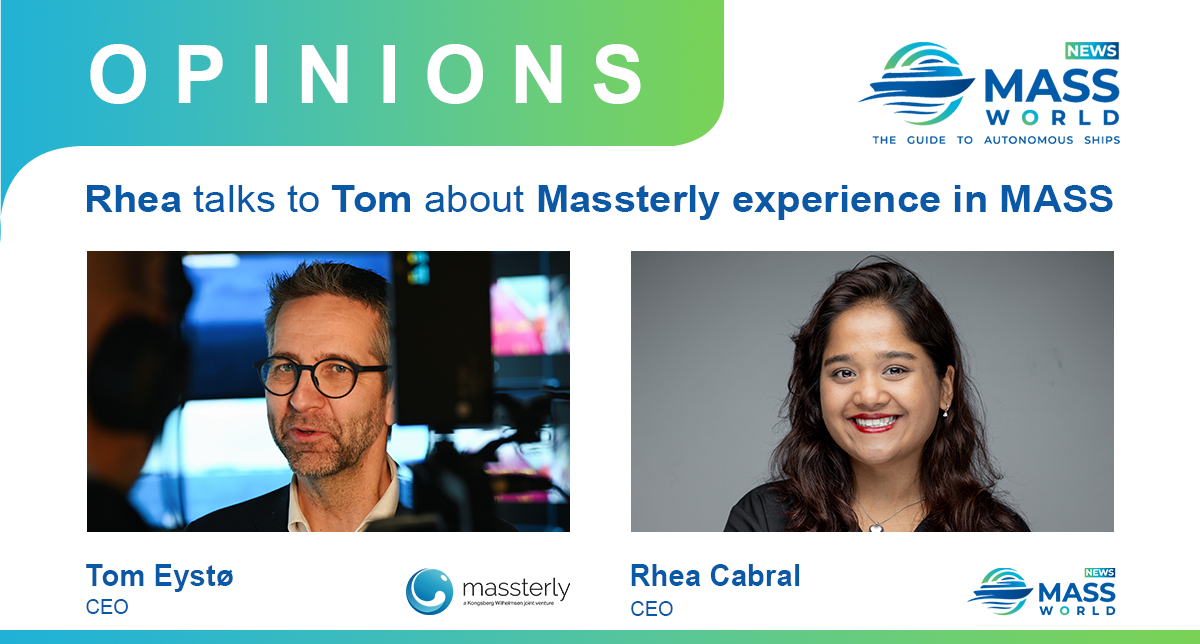Autonomous ships at a glance with Massterly

Today, Rhea Cabral, MASSworld.news CEO, talks to Tom Eystø¸ Massterly CEO and keynote speaker at Autonomous Ship Conference 2024.
Tom Eystø is the CEO of Massterly (Kongsberg Wilhelmsen joint venture), an autonomous shipping company. He has over 20 years of experience from Kongsberg Maritime. Before joining Massterly, he held the position of Vice president of bridge systems in Kongsberg Maritime, including Head of Autonomy Program at that time. Tom also worked 3 years outside Norway, in Singapore as a Regional Support Manager. His background includes 5 years in the Royal Norwegian Navy, and a bachelor’s degree in mechatronics.
❓ As a keynote speaker at the Autonomous Ship Conference 2024 (a part of Autonomous Ship Expo), could you provide us with an overview of what you plan to talk about?
? As Massterly is one of the first companies to have commercial projects in the MASS segment i will focus on status in the projects, and challenges that we face taking grand ideas from PowerPoint to reality. I will also share progress in REACH Remote as we are getting close to start testing these unique vessels.
❓ How has Massterly achieved the level of success of being one of the most experienced and well contracted MASS company globally?
? The fact that we have had commercial contracts from the start has been a huge benefit. To work with this type of innovation with a strong commercial driver, I believe, is a key to success. I would also give credit for our success to our customers and owners who support the development. It’s also important to highlight that the autonomous technology is not the main driver for our project, but the enabler for zero emission logistics on water, and even though autonomous sailing is somewhat delayed, both for ASKO and Yara International vessels are in operation, so the environmental goal is reached, and this is the most important goal for society. Autonomy is for safety and reduced the operating cost for water born transportation to compete with trucks on short distances.
❓ Which companies support Massterly?
? Massterly is a joint venture 50/50 owned by Kongsberg Maritime and Wilhelmsen group New Energy. This is a unique combination of a strong world leading maritime technical solution provider, with one of the largest providers of marine services and operations in the world.
❓ What vessels do you operate at the moment, and do you plan to take any more into control in the near future?
? Currently we are operating “YARA Birkeland” for Yara International, and “Marit” and “Therese” for ASKO Maritime AS. These are all to be fully autonomous, and uncrewed in the future, but are currently operated fully automatic but with a skeleton crew onboard. Responsibility still lies with the captain onboard. We are also preparing now to take “REACH Remote 1” into operation. This is a 24-meter USV that will be unmanned from start of operation, and in addition to autonomous functionality can be remote controlled. Operation for Yara International and ASKO is logistics, and Reach Subsea is for ROV operation, subsea survey.
❓ Most of your projects are Norwegian, do you have plans to expand to the worldwide market or focus on the local market for now?
? While all our projects are Norwegian, Massterly has its sights set on the global market. We recognize the immense potential for autonomous shipping worldwide. Our goal is to facilitate a shift from road transport to sea transport, promoting efficiency, safety, and environmental sustainability. REACH Remote have huge potential outside Norway. So, yes, we’re actively exploring opportunities beyond our local market. We also believe that the process for approval towards the Norwegian authorities and DNV as class, we will be able to reuse outside Norway.
❓ How do you foresee the advancements in developing and implementing autonomous ship technology impacting the future of maritime logistics? What have some of the most significant challenges been for Massterly?
? The advancements in autonomous ship technology will transform maritime logistics. It will not be a revolution, but an evolution.
Benefits include:
? Efficiency: Autonomous vessels can optimize routes, reduce fuel consumption, and enhance cargo handling.
? Safety: Automation minimizes human error and improves collision avoidance.
? Environmental Impact: Lower emissions and reduced ecological footprint.
Challenges for Massterly include regulatory compliance, cybersecurity, and ensuring seamless integration of autonomous ships into existing maritime operations.
❓ What path should one take to become a ROC operator?
? Massterly (a Kongsberg Wilhelmsen joint venture) is currently hiring crew for remote operation center, and our criteria are that they should hold the same certificate according to the position they are replacing onboard. During the test period they will be alternating between operating on the vessel and in the ROC. We are also working closely with the University of South-Eastern Norway (USN), to develop a curriculum to be a part of their navigator and marine engineering program.
❓ I am sure many of our readers would like to know, what steps would one need to take to become a member of the Massterly team?
? A keen interest in new technology, and willing to be part of the new development in the shipping industry.
See also related
Countries
Recent updates
Anduril Partners with HD Hyundai to Build Autonomous Warships
ORCAUBOAT's autonomous navigation system receives China Classification Society type approval
Lightfish USV completes fastest transatlantic crossing
Electric hydrofoil ferry with autonomous shipping technologies starts tests on the Trondheim Fjord
SeaBot Maritime and University of Plymouth Sign MoU to Advance Marine Autonomy Training
ROC + DOCK project demonstrates future of resident USV operations
Research project to teach MASS operate with critical navigation data
